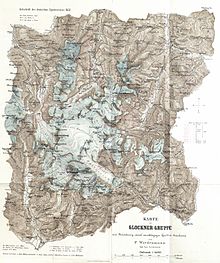Peter von Wiedenmann
Peter Wiedenmann , 1870 Knights of Wiedenmann , from 1901 Baron Wiedenmann (* 11. May 1847 in Munich , † 8. July 1917 ) was a Bavarian Artillery General , Adjutant General and 1900/12 as CEO of Secret Registry of Prince Regent Luitpold a of the most influential people in the kingdom.
Life
origin
Wiedenmann was the son of a master tailor . In 1873 he married Fanny, née Gehm. The marriage had four children.
Military career
After he had graduated from the vocational school and the polytechnic , Wiedenmann joined the 1st field artillery regiment "Prince Regent Luitpold" of the Bavarian Army as a volunteer in 1863 . In 1865 he was assigned to the topographic office for training . The following year, Wiedenmann was promoted to lieutenant and transferred to the 11th Infantry Regiment "von der Tann" . With this regiment he took part in the war against Prussia in 1866 and fought near Zella, Kissingen and Helmstadt . After the defeat in the Main Campaign , Wiedenmann returned with his troops to the garrison and he was once again commanded to the topographic office. Relocated to the 1st field artillery regiment "Prince Regent Luitpold" at the beginning of 1870, Wiedenmann was deployed in the war against France at the Battle of Orléans and the enclosure and siege of Paris . He proved himself so well that he was awarded the Knight's Cross of the Military Max Joseph Order by King Ludwig II . With the award the elevation to the personal nobility was connected and he was allowed to call himself "Ritter von Wiedenmann" after the entry in the nobility register . He had also received the Iron Cross, 2nd class.
After the peace agreement, Wiedenmann, meanwhile Prime Lieutenant , graduated from the War Academy from 1871/74 , which made him qualified for the subject (military geography). He then returned to military service and was appointed to the military academy as a teacher of military geography in 1876. In 1882 he was promoted to captain and as such he was appointed battery chief in the 3rd field artillery regiment "Queen Mother" in July 1885 . Placed à la suite of the regiment on June 28, 1886 , Wiedenmann was appointed wing adjutant to Prince Regent Luitpold on the same day . In this position he rose in the years to come, until he was finally promoted to major general on March 21, 1900 and appointed adjutant general on December 6, 1900. With this appointment, Wiedenmann also took over the management of the secret chancellery of the Prince Regent. This was created in 1886 in place of the dissolved cabinet secretariat and the executive board was one of the most important political advisors to the Prince Regent. As an active officer, Wiedenmann was promoted further; on September 8, 1902 to lieutenant general and on July 11, 1905 to general of the artillery. In addition, in 1901 he was raised to the hereditary Bavarian baron status and knight of the Order of Hubert . Wiedenmann was also the holder of the Order of Merit of the Prussian Crown .
After Luitpold's death, Wiedenmann was put up for disposal at the end of December 1912 . The Wiedenmann Glacier in Antarctica is named after him.
literature
- Othmar Hackl : The Bavarian War Academy (1867-1914). CH Beck´sche Verlagsbuchhandlung, Munich 1989, ISBN 3-406-10490-8 , p. 604.
Individual evidence
- ^ Bavarian War Ministry (ed.): Military manual of the Kingdom of Bavaria. 1885, p. 163.
- ↑ Othmar Hackl: The Bavarian War Academy (1867-1914). CH Beck´sche publishing house bookstore. Munich 1989. ISBN 3-406-10490-8 . P. 604.
- ^ Bavarian War Ministry (ed.): Military manual of the Kingdom of Bavaria. 1889. p. 2.
- ↑ a b Bavarian War Ministry (ed.): Military manual of the Kingdom of Bavaria. 1909. pp. 190f.
- ^ Bavarian War Ministry (ed.): Military manual of the Kingdom of Bavaria. 1901, p. 2.
- ↑ Prince Regent Luitpold and the Secret Chancellery in: House of Bavarian History , last accessed on May 14, 2019.
- ↑ Kurt-Gerhard Klietmann : The Order of Merit of the Prussian Crown. Message from the Institute for Scientific Order Studies. In: The Herald . Volume 12, Volume 32, 1989, Issue 9, p. 248.
| personal data | |
|---|---|
| SURNAME | Wiedenmann, Peter von |
| ALTERNATIVE NAMES | Wiedemann, Peter (maiden name); Wiedenmann, Peter Ritter von; Wiedenmann, Peter Freiherr von |
| BRIEF DESCRIPTION | Bavarian general of the artillery |
| DATE OF BIRTH | May 11, 1847 |
| PLACE OF BIRTH | Munich |
| DATE OF DEATH | July 8, 1917 |
| Place of death | Munich |
